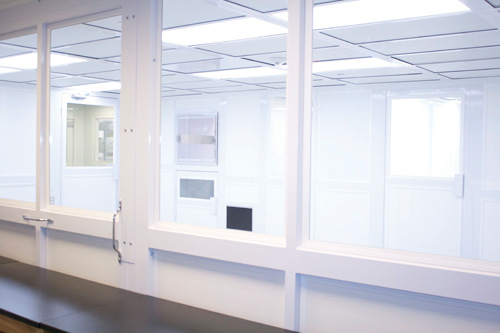Monitor Viable Air with Single-Use, Real-Time Tech
Recent Advancements Address Regulatory Requirements for Monitoring of Cleanrooms
 Viable air monitoring is a crucial part of
an environmental monitoring program.
Because common viable air monitoring
methodologies have not been introduced
in many years, monitoring in critical
manufacturing areas like Grade A, RABS
and isolators creates a dilemma for the
industry.
Viable air monitoring is a crucial part of
an environmental monitoring program.
Because common viable air monitoring
methodologies have not been introduced
in many years, monitoring in critical
manufacturing areas like Grade A, RABS
and isolators creates a dilemma for the
industry.
Traditional methods lack the necessary sensitivity. Singular results only provide an indicator of cleanroom status; often there is no direct correlation between number of organisms and product contamination risks (1).
A defensible monitoring program should be based on the following criteria:
- Frequency of testing: Frequent/ continuous
- Location: Close to critical points
- Performance: Without adding any contamination risk to the product
With most traditional methods, it is virtually impossible to achieve a defensible monitoring program. Manufacturers frequently disregard the fact that handheld instrumentation contributes to particle load of an area and causes flow turbulences close to manufacturing. Mobile devices cannot be properly sterilized for use in Grade A environments.
For process security, viable air monitoring devices that can sample remotely into ISO Grade 5 areas must be installed. In the near future, international inspectors will not accept any handheld devices in critical areas.
When remotely sampling very close to critical control points, a risk assessment can determine whether the manipulation and cleaning procedures for the remote atriums used impose a risk to the patient or the product. Knowing that, in many cases, the risk cannot be correctly assessed, as traditional viable air sampling techniques do not produce realistic views of the environment, manufacturers may consider the use of single-use air sampling atriums to drastically reduce operator handling close to the critical zone. A risk-based approach includes the use of real-time viable air testing during media fill (process validation) exercises, enabling the manufacturer to map the full critical process in real-time operation.
There are two options to ensure the full manufacturing process is continuously monitored with data generated: single-use and real-time technologies.
Single-use technologies have been validated for long-term, two-hour sampling in critical environments at 25 LPM. In an eight-hour process model, this relates to only four sampling units covering the full manufacturing process for viable air sampling, limiting the need to frequently interfere with the process.
Continuous viable air sampling can also be managed by a real-time monitoring device instrument. Data accumulated by this instrument better equips manufacturers with a full understanding of the manufacturing environment and allows for immediate action when critical concentrations of biological counts are reached. Lines can be stopped, material waste avoided, and quality assurance dramatically increased with a perceptible decrease in production loss and cost.
Real-time viable measuring tools not only capture culturable microorganisms, but also viable, nonculturable microorganisms, well known in the pharmaceutical industry to be a risk not controlled by current sampling technologies. As a result, counts of those technologies are generally higher in contaminated areas, but zero counts are also possible in critical environments. When moving to these technologies, it is possible for manufacturers to detect some biological counts where previously zero CFU with traditional methods would be common. Regulators indicate that the primary advantage of better process control could be attained by occasionally finding a biological count in areas where it is not expected. Incidents of biological counts in critical areas are detected almost regularly, but strong deviations from this trend and frequency indicate in real time whether the process is out of control and needs to be readjusted.
As with particle monitoring, a correct selection of alert and action limits must be based on a risk assessment and a consistent amount of trending data. ISO 14644-2 recommends the selection of a reasonable alarm notification strategy, not based on a single-event triggering alarm, but on a combination of multiple out-ofspecification counts over a period of time. The main goal of selecting the appropriate alert/action alarm strategy is essential to avoid nuisance alarm events that could be ignored by operators (2).
A disadvantage of real-time viable monitors is the fact that identification of contaminants is not possible due to the nature of the detected microorganisms. Therefore, pharmaceutical manufacturers are advised to combine real-time viable testing with a continuous viable monitoring approach. With this combination, the safety of the drug and process will be moved to a higher standard, protecting patients from microbial contaminations.
Regulatory Concerns Justify New Tech
With the introduction of modern manufacturing concepts and an increasing number of industry standards, there is a need to adopt viable air monitoring in conjunction with the most recent regulatory trends (3). Regulations provide specifications for the selection of a viable air monitoring strategy.
ISO standards are becoming more important as a reference for the pharmaceutical industry. The EU GMP Annex 1 explains that ISO/EN norms should be considered as reference documents when it comes to detailing methods for the determination of microbiological and particulate cleanliness of air, surfaces, etc. (4).
The ISO 14698 standard states that “a sampling device shall be selected according to the area being monitored” (5). Looking at the expected concentration of viable particles in different clean zones, in critical areas like Grade A/ ISO 5 with expected low to zero counts of microorganisms, high sampling volumes or continuous sampling is preferable (1,4,6). the EU GMP Guide supports this: “Where aseptic operations are performed monitoring should be frequent using methods such as settle plates, volumetric air and surface sampling” (4). Also, U.S. regulations state “sample sizes should be sufficient to optimize detection of environmental contaminants at levels that might be expected in a given clean area” (7) and “routine microbial monitoring should provide sufficient information to demonstrate that the aseptic processing environment is operating in an adequate state of control” (8).
Under European guidelines, “for Grade A zones, particle monitoring should be undertaken for the full duration of critical processing” (4). Particulate matter not only consists of inert, nonviable particles, but also viable particles. Continuous monitoring of viable particles should be undertaken for ISO 5/Grade A cleanroom settings.
When considering risk zones, manufacturers typically focus on Grade A/ISO 5 areas, and not the overall cleanroom concept, which includes Grade B, C and ISO 7 zones. Contaminations in areas surrounding ISO 5 can significantly contribute to product/patient contamination risk; thus, similar monitoring plans should be considered when selecting the instrumentation for those environments.
Both U.S. and European regulatory guidelines and ISO standards outline the need for routine monitoring of cleanrooms. Using single-use and real-time technologies in conjunction offers a way to address these requirements by bringing manufacturing processes to a greater level of quality.
References
- Saghee, R., Sandle, T. and Tidswell, E. (2011). Microbiology and Sterility Assurance in Pharmaceuticals and Medical Devices. New Delhi: Business Horizons, 2011.
- ISO 14644-2. (2015).
- Guidance for Industry: PAT — A Framework for Innovative Pharmaceutical Development, Manufacturing, and Quality Assurance, 2004, U.S. FDA.
- EU Guidelines to Good Manufacturing Practice. (2008), Volume 4, Annex 1
- ISO 14698-1. (2003).
- ISO 14644-1. (2015).
- Guidance for Industry: Sterile Drug Products Produced by Aseptic Processing - Current Good Manufacturing Process, 2004, U.S. FDA
- USP 39 NF 34. (2016). Microbiological Control and Monitoring of Aseptic Processing Environments. Chapter <1116>, <1430>



 Frank Panofen, PhD, has
expansive experience in the
field of applied pharmaceutical
microbiology and serves as the
Sterility Assurance/Microbiology
Product Line Manager at Particle
Measuring Systems.
Frank Panofen, PhD, has
expansive experience in the
field of applied pharmaceutical
microbiology and serves as the
Sterility Assurance/Microbiology
Product Line Manager at Particle
Measuring Systems.